Choosing Safety Footwear for Construction: Key Considerations and Recommendations
In the bustling world of construction, where ambitious structures rise from the ground, and skilled hands shape the urban landscape, the safety of workers remains an ever-present concern. Within this dynamic environment, the significance of proper safety measures cannot be overstated, and one vital aspect that demands unwavering attention is safety footwear. This blog post delves into the critical role of safety footwear in the construction industry, exploring the hazards that frequently beset construction sites and the essential safety requirements that safeguard workers' feet.
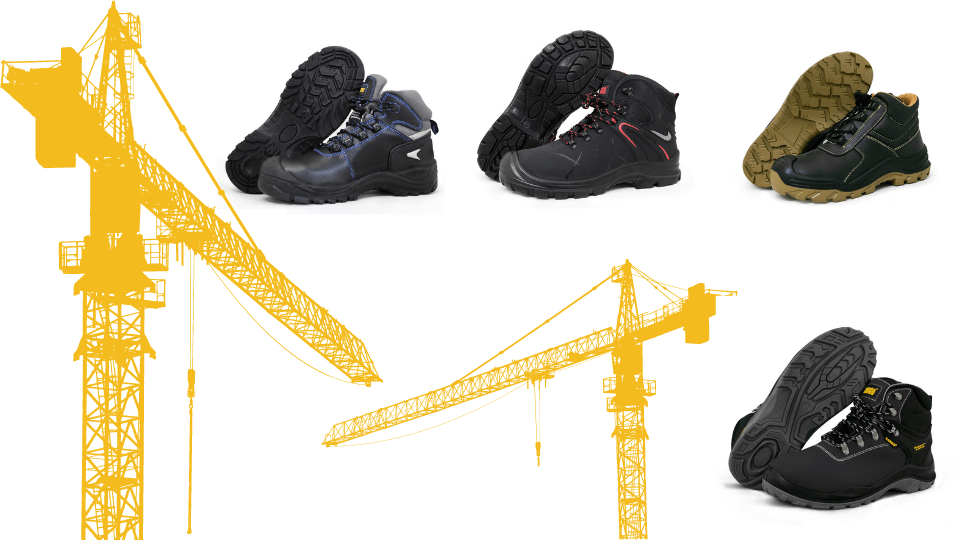
TABLE OF CONTENTS
- Understanding Construction Site Hazards
- Key Considerations for Safety Footwear Selection
- Types of Safety Footwear for Construction Workers
- Tips for Proper Fit and Maintenance of Safety Footwear
We'll shed light on the crucial considerations involved in selecting appropriate safety footwear for construction industry workers. By understanding the hazards, they encounter and the corresponding safety needs, workers can make informed decisions when choosing the most suitable protective footwear for their specific roles.
Additionally, we aim to provide recommendations and examples of safety footwear options that align with the unique demands of construction environments, empowering workers to tackle their tasks with confidence and security. Through this exploration, we hope to foster a culture of safety consciousness on construction sites, emphasising the importance of safeguarding the well-being of those who build the foundations of our modern world.
Understanding Construction Site Hazards
Construction sites are dynamic environments teeming with activity, where progress and creativity merge. However, amidst productivity and innovation, a myriad of hazards lurk, posing potential risks to the well-being of workers. To ensure the safety of those toiling on these sites, it is essential to comprehend the common hazards that construction industry workers encounter and, specifically, how they can impact their feet.
Overview of Common Hazards Encountered on Construction Sites
- Falling Objects: Construction sites are rife with materials, tools, and equipment frequently moved and manipulated at various heights. Falling objects pose a significant risk to workers, with the potential to cause severe injuries to their feet.
- Heavy Machinery and Equipment: The presence of heavy machinery and equipment, such as cranes, forklifts, and excavators, can lead to accidental collisions or crushing incidents that endanger workers' feet.
- Sharp and Pointed Objects: Debris, nails, shards of glass, and other sharp objects often scatter around construction sites, posing a constant threat to unprotected feet.
- Slips, Trips, and Falls: Uneven surfaces, wet conditions, and cluttered pathways can cause slips, trips, and falls, putting workers' feet at risk of fractures and sprains.
- Chemicals and Hazardous Substances: Construction materials and processes may involve the use of chemicals and hazardous substances that can cause chemical burns and skin irritations if they come into contact with workers' feet.
- Electrical Hazards: Construction sites often have live electrical wires and equipment, which can lead to electrical shocks and burns if proper safety precautions are not followed.
- Extreme Temperatures: Construction workers may encounter extreme temperatures, both hot and cold, which can cause burns, frostbite, or thermal injuries to their feet.
Impact of Hazards on Workers' Feet
The hazards present on construction sites can have severe consequences for workers' feet. Without adequate protection, the feet are vulnerable to a range of injuries, including:
- Crush Injuries: Heavy objects or machinery can crush the feet, resulting in fractures, contusions, and even amputations.
- Puncture Wounds: Sharp objects can penetrate footwear and pierce the skin, leading to painful puncture wounds and potential infections.
- Sprains and Fractures: Slips, trips, and falls can cause sprains and fractures, causing considerable pain and hindering a worker's ability to perform their duties.
- Chemical and Electrical Burns: Exposure to chemicals and electrical hazards can lead to burns and other harmful effects on the skin of the feet.
- Frostbite and Burns: Extreme temperatures can cause frostbite in cold conditions and burns in hot conditions, affecting the skin and tissues of the feet.
To mitigate these risks and ensure the well-being of construction industry workers, the selection of appropriate safety footwear becomes an indispensable aspect of their personal protective equipment (PPE) ensemble. In the subsequent sections, we will explore the key considerations and recommendations for choosing safety footwear that effectively addresses the hazards present on construction sites, providing workers with the necessary protection to carry out their tasks with confidence and peace of mind.
Key Considerations for Safety Footwear Selection
Ensuring the safety and well-being of construction workers is of paramount importance in the dynamic and hazardous environment of construction sites. One crucial aspect of Health and Safety in construction is the selection of appropriate safety footwear, which can significantly reduce the risk of foot injuries and enhance overall job performance. In this section, we will explore the key considerations for choosing safety footwear, including safety standards, toe protection, slip resistance, ankle support, and electrical hazard protection.
Footwear Safety Standards
Identifying Applicable Safety Standards (e.g., EN ISO 20345)
In the realm of safety footwear, adherence to specific standards is crucial to guarantee the efficacy of protective features. One widely recognised standard is EN ISO 20345, which outlines the requirements for safety footwear across Europe. Understanding and identifying such applicable safety standards are paramount when selecting appropriate safety footwear for construction workers.
EN ISO 20345 also known as EN345 is a safety standard that specifies basic and additional (optional) requirements for safety footwear used for general purposes. It includes for example, mechanical risks, slip resistance, thermal risks, and ergonomic behaviour. Special risks are covered by complementary job-related standards (e.g. footwear for firefighters, electrical insulating footwear, protection against chain saw injuries, protection against chemicals and molten metal splash, or protection for motorcycle riders).
Importance of Certified Safety Footwear
Opting for certified safety footwear signifies a commitment to quality and assurance. Certified safety footwear undergoes rigorous testing to meet the stipulated safety standards, assuring workers that the chosen footwear has been thoroughly evaluated and approved for its protective attributes. These certifications provide peace of mind to both employers and workers, knowing that they are investing in footwear that prioritises their safety and well-being.
LEARN MORE: Footwear Safety Standards: The Ultimate Guide To EN345
Toe Protection
Steel Toe vs. Composite: Pros and Cons
Toe protection is a fundamental aspect of safety footwear, shielding workers' feet from falling objects and compression hazards. Two primary types of toe protection are commonly available: steel toe cap and composite toe cap.
- Steel Toe Cap: Time-tested and robust, steel toe caps offer excellent protection against heavy impacts and compression. Their sturdy construction ensures that construction workers' feet remain shielded from falling objects and heavy machinery mishaps, safeguarding against potentially debilitating injuries. However, it is essential to note that steel toes may have a drawback in extreme weather conditions, as they can conduct temperature, potentially causing discomfort to workers in hot or cold environments.
- Composite Toe Cap: Crafted from non-metallic materials such as Kevlar, carbon fibre, or reinforced plastic, these toe caps provide a level of protection that rivals their steel counterparts, without the conductivity issue that concerns some workers. Their non-metallic nature not only alleviates the discomfort of temperature conductivity but also renders them ideal for workers who frequently encounter metal detectors in their work environments. Moreover, composite toes boast a distinct advantage in terms of weight, being considerably lighter than steel toes, thereby reducing fatigue and enhancing overall comfort during extended work hours.
Recommended Toe Protection for Different Construction Tasks
The choice of toe protection depends on the specific tasks performed by construction workers:
- Steel Toe Cap: When tackling tasks that involve handling heavy materials, operating machinery, or working in areas with potential crushing hazards, steel toes stand as the go-to choice. Their time-tested durability and robust construction offer unmatched protection, ensuring that workers' feet remain shielded from the formidable forces they encounter daily. For scenarios where the risk of heavy objects falling or machinery-related accidents is high, steel toes are an indispensable asset, providing a formidable barrier against potentially devastating injuries.
- Composite Toe Cap: For workers who require toe protection but frequently encounter metal detectors in their daily work routines, composite toes are the recommended solution. Made from non-metallic materials such as Kevlar, carbon fibre, or reinforced plastic, composite toes offer comparable protection to their steel counterparts without triggering the sensitivity of metal detectors. This characteristic renders them particularly advantageous for workers in industries where strict security measures demand non-metallic safety footwear. Additionally, composite toes are notably lighter than steel toes, alleviating fatigue and enhancing overall comfort during long hours of work.
When considering the choice between steel and composite toes, workers in the construction industry can make informed decisions based on their specific needs and preferences. While steel toes excel in robustness and longstanding reliability, composite toes offer an innovative alternative that balances protection, comfort, and the elimination of conductivity concerns. Ultimately, both options serve as valuable assets in ensuring the utmost safety for construction workers, allowing them to focus on their tasks with confidence and peace of mind.
| Steel Toe Cap Safety Boots | Composite Toe Cap Safety Boots |
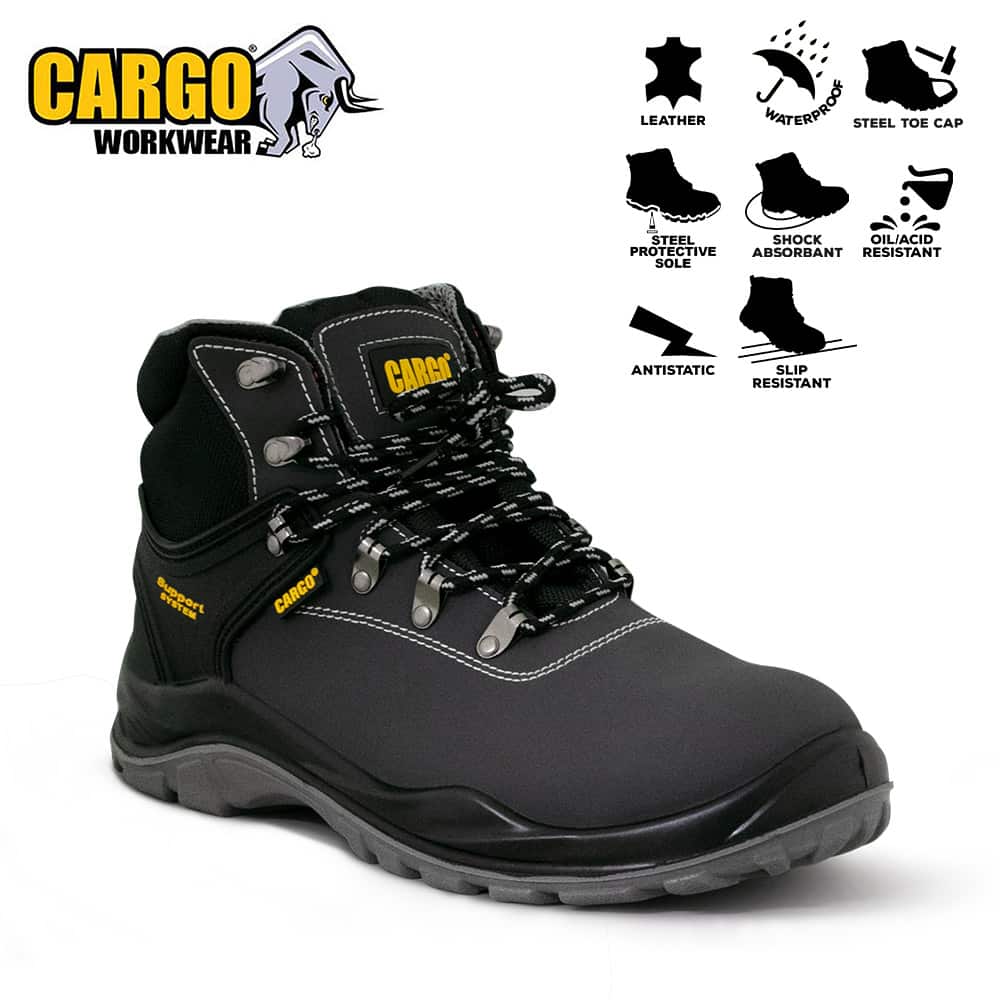 |
 |
Sole and Slip Resistance
Types of Outsoles for Construction Safety Footwear
Construction safety footwear is available with various types of outsoles, each designed to address specific work conditions. Common types of outsoles include:
- Rubber Outsoles: Offering durability, slip resistance, and excellent traction on various surfaces, rubber outsoles are well-suited for a wide range of construction tasks.
- Polyurethane (PU) Outsoles: Known for their shock-absorption properties, PU outsoles are a good choice for workers exposed to concrete and hard surfaces for prolonged periods.
- TPU (Thermoplastic Polyurethane) Outsoles: Combining the benefits of rubber and PU, TPU outsoles offer enhanced abrasion resistance, grip, and durability.
Slip Resistance Ratings: What to Look For
When evaluating safety footwear for construction, pay attention to slip resistance ratings. Look for outsoles with high slip resistance ratings, such as SRC, which signifies that the footwear has been tested and proven to provide excellent slip resistance on both ceramic tile and steel surfaces. Slip-resistant outsoles are crucial for maintaining stability and preventing accidents in unpredictable construction site conditions.
| Safety Boots with SRC Slip Resistance Rating |
 |
Ankle Support and Stability
Importance of Ankle Support for Construction Workers
The nature of construction work often involves navigating uneven terrain, climbing, and handling heavy loads. Ankle support plays a vital role in reducing the risk of sprains, twists, and other injuries. Proper ankle support helps maintain stability during physically demanding tasks, providing added confidence and reducing the chances of accidents.
Features to Enhance Foot and Ankle Stability
Look for safety footwear that incorporates features to enhance foot and ankle stability:
- High-Cut Designs: High-cut safety footwear, such as safety boots, provides additional support to the ankle, making them suitable for tasks requiring more stability.
- Padded Collars: Padded collars offer cushioning and support around the ankle, reducing pressure points and enhancing comfort.
- Lacing Systems: Footwear with secure lacing systems allows for a custom fit, ensuring proper support around the ankle.
| Safety Boots with Ankle Support |
 |
Electrical Hazard Protection
Understanding Electrical Hazard Safety Footwear
For construction workers exposed to electrical hazards, electrical hazard (EH) safety footwear is indispensable. EH-rated footwear is designed to reduce the risk of electrical shocks and protect workers from open circuits and live wires. They are often constructed with non-conductive materials, creating a barrier that hinders electrical currents from passing through the footwear to the ground.
Suitable Footwear for Electrically Hazardous Environments
In electrically hazardous environments, opt for safety footwear with EH certification. These boots or shoes are specially engineered to provide an additional layer of protection against electrical shocks, making them essential for electricians, utility workers, and others working near live electrical equipment.
By taking these key considerations into account when selecting safety footwear for construction workers, employers can equip their workforce with the appropriate protection needed to navigate the myriad hazards present on construction sites. Prioritising safety in this manner not only ensures compliance with industry standards but also fosters a culture of care and well-being, safeguarding those who dedicate their skills to building a brighter future.
Types of Safety Footwear for Construction Workers
Construction workers face a myriad of hazards in their day-to-day tasks, making appropriate safety footwear an indispensable element of their personal protective equipment (PPE). Here, we explore different types of safety footwear tailored to the specific needs of construction workers, along with their benefits and recommended usage:
Safety Boots
Safety boots are a staple in the construction industry, designed to offer comprehensive foot protection and support. When selecting safety boots, workers are often faced with the choice between high-cut and low-cut styles.
High-Cut vs. Low-Cut: Choosing the Right Style
- High-Cut Safety Boots: Characterized by their extended upper that covers the ankle, high-cut safety boots provide enhanced ankle support and stability. These boots are well-suited for construction tasks involving heavy lifting, climbing, and traversing uneven terrain, as they offer added protection to the ankles and lower legs.
- Low-Cut Safety Boots: With a lower upper that sits just above the ankle, low-cut safety boots offer greater flexibility and ease of movement. They are ideal for tasks that require agility and quick movements, such as tasks involving light construction work or jobs in less hazardous environments.
Recommended Safety Boots for Different Construction Tasks
- Heavy-Duty Safety Boots with Steel Toes: Recommended for construction tasks involving heavy materials, equipment handling, and potential crushing hazards.
- Composite Toe Safety Boots: Ideal for workers requiring toe protection while facing regular metal detectors or needing lighter footwear without compromising on safety.
| Steel Toe Cap Safety Boots | Composite Toe Cap Safety Boots |
 |
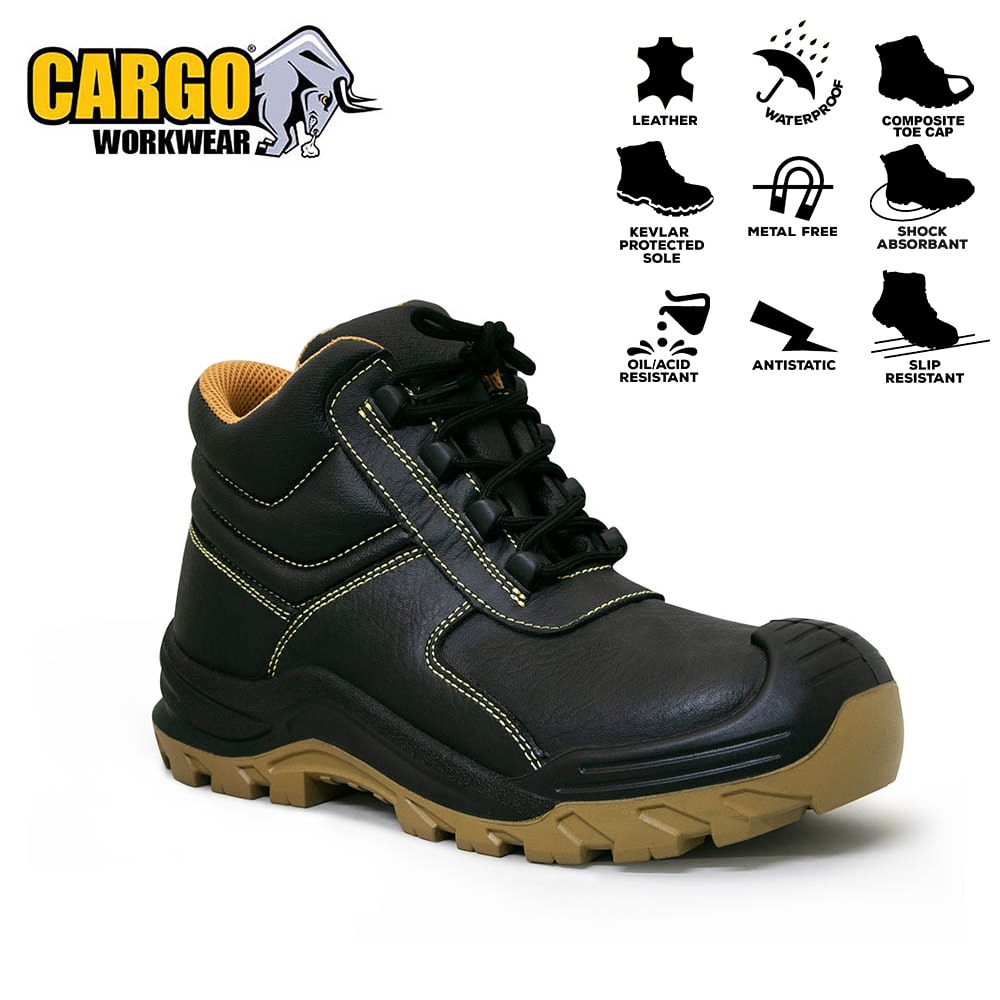 |
Safety Shoes
Safety shoes are a viable alternative to safety boots for certain construction roles, providing adequate protection while offering increased comfort and versatility.
Benefits of Safety Shoes for Specific Construction Roles
- Lightweight and Agile: Safety shoes are designed to be lightweight, providing workers with increased agility and reduced fatigue during long hours of work.
- Specific Design Features: Some safety shoes are tailored for specific roles, such as electrical hazard protection for electricians or slip-resistant soles for workers in slippery environments.
Top Safety Shoe Options for Construction Industry Workers
- Pierce-Resistant Sole Safety Shoes: Construction workers exposed to sharp objects or nails scattered on job sites benefit from pierce-resistant sole safety shoes. With reinforced soles crafted from materials like steel or Kevlar, these shoes act as a protective shield, reducing the risk of foot injuries from punctures or sharp hazards.
- Slip-Resistant Safety Shoes: Ideal for workers dealing with slippery surfaces, ensuring stability and preventing slip-related accidents.
| Pierce-Resistant Sole Safety Shoes | Slip-Resistant Safety Shoes |
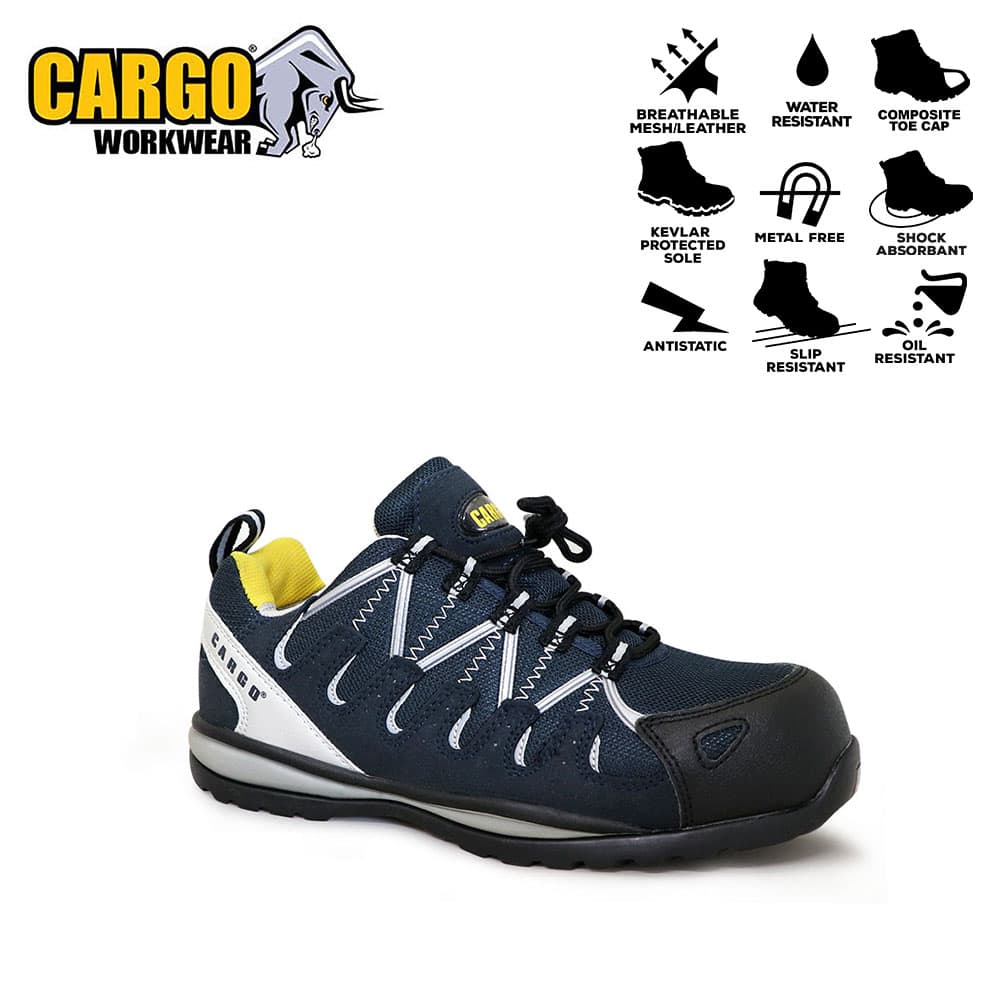 |
 |
Metatarsal Guard Footwear
Advantages of Metatarsal Guard Protection
Metatarsal guard footwear offers an additional layer of protection to the metatarsal bones, which are vulnerable to impacts and compression hazards. These specialized boots incorporate metatarsal guards over the laces, shielding the sensitive bones from falling objects or heavy materials.
Instances Where Metatarsal Guard Footwear is Essential
Workers involved in activities where the risk of heavy objects or machinery-related accidents impacting the metatarsal area is high should wear metatarsal guard footwear. Jobs such as handling heavy loads, operating heavy machinery, or working in areas with frequent crushing hazards necessitate the use of this specialized protective gear.
| Safety Boots with Metatarsal Guard Protection |
 |
Wellington Boots (Safety Wellingtons)
The Versatility of Wellington Boots in Construction
Wellington boots, also known as safety wellingtons, offer a unique combination of waterproof protection and safety features. They are highly versatile, making them suitable for various construction tasks, particularly in wet or muddy environments.
Features to Look for in Safety Wellingtons
- Waterproof: Wellington boots should provide a reliable waterproof barrier, keeping workers' feet dry in wet conditions.
- Slip-Resistant Outsoles: Slip-resistant soles are crucial for maintaining stability on slippery surfaces.
| Wellington Boots (Safety Wellingtons) |
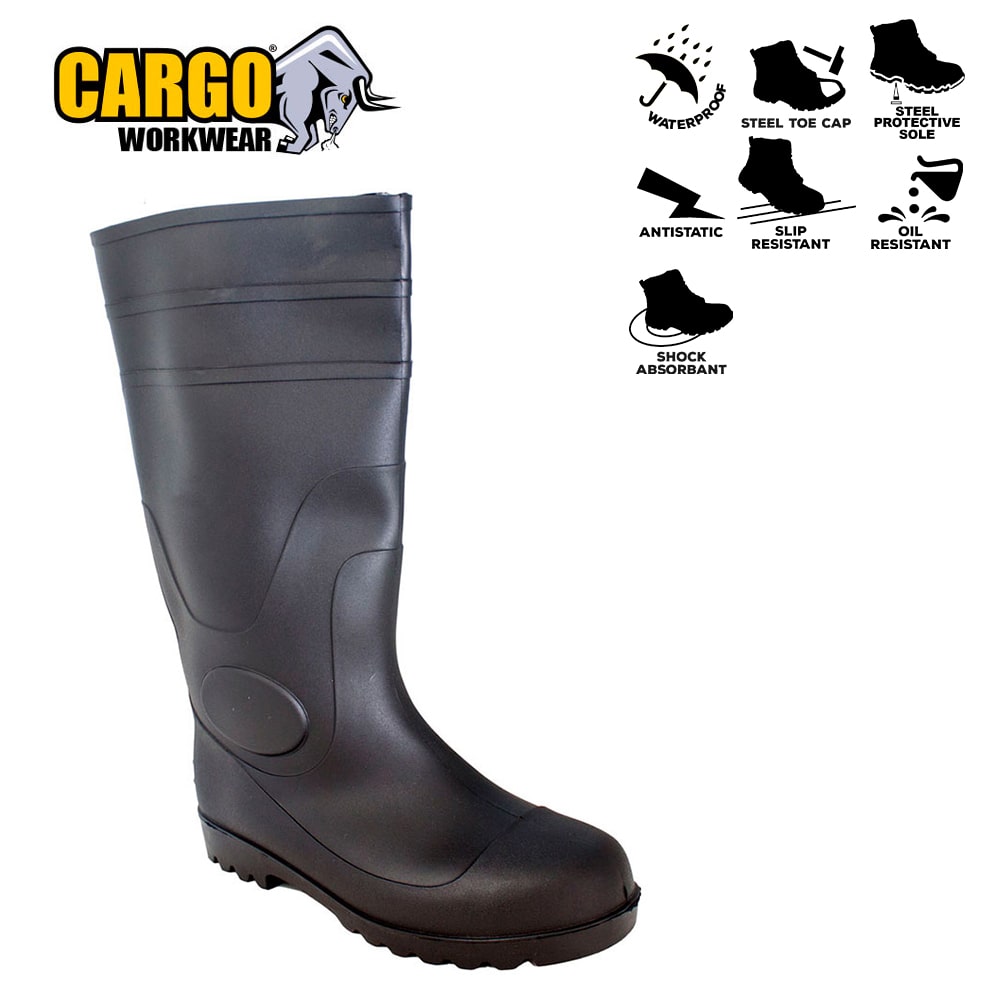 |
By carefully considering the specific demands of different construction tasks and the features offered by various safety footwear options, workers and employers can select the most appropriate protective gear. Providing construction workers with the right safety footwear not only enhances their on-site safety but also promotes productivity and well-being, underlining the importance of prioritising the well-being of those who build the foundation of our communities.
Tips for Proper Fit and Maintenance of Safety Footwear
Investing in high-quality safety footwear is only the first step in ensuring the well-being of construction workers. To maximize the protective capabilities of safety footwear and prolong their lifespan, it is crucial to pay attention to proper fit and regular maintenance. Here are essential tips for achieving the best fit and keeping safety footwear in optimal condition:
Ensure a Proper Fit
A proper fit is fundamental to the effectiveness of safety footwear. Ill-fitting footwear can cause discomfort and blisters, and reduce overall job performance. To ensure a proper fit:
- Measure Both Feet: Measure both feet before selecting safety footwear, as foot size can vary between feet. Choose the size that fits the larger foot comfortably.
- Try on Safety Footwear with Work Socks: Wear the type of work socks that will be worn on the job when trying on safety footwear. This ensures the most accurate fit for on-the-job conditions.
- Allow for Toe Wiggle Room: There should be enough space at the toe box for toes to wiggle comfortably, preventing constriction during movement.
- Check for Heel Slippage: The heel should fit snugly and not slip inside the footwear, as this can lead to blisters and instability.
- Walk and Test Comfort: Walk around in the safety footwear to assess comfort and fit. Ensure there are no pressure points or areas causing discomfort.
Regularly Inspect and Maintain Safety Footwear
Proper maintenance of safety footwear is essential to preserve its protective features and durability. Regularly inspect and maintain safety footwear with these guidelines:
- Daily Inspection: Before each use, inspect safety footwear for signs of wear, damage, or deterioration. Check for loose stitching, worn outsoles, or any issues that may compromise protection.
- Clean and Dry: After each use, clean safety footwear by wiping off dirt and debris. Allow them to air dry thoroughly before storage.
- Avoid Extreme Temperatures: Avoid exposing safety footwear to extreme temperatures, as this can weaken the materials and reduce their protective properties.
- Replace Worn-Out Footwear: When safety footwear shows significant signs of wear, such as worn-out soles or damaged protective features, it is essential to replace them promptly. Continuing to use worn-out footwear compromises safety and increases the risk of foot injuries.
- Follow Manufacturer's Instructions: Adhere to the manufacturer's guidelines for maintenance and care. Some safety footwear may require specific cleaning methods or periodic reapplication of protective treatments.
By following these tips for proper fit and maintenance, construction workers can ensure their safety footwear remains effective and reliable in protecting their feet throughout their demanding workdays. A commitment to regular inspection and care not only extends the life of safety footwear but also demonstrates a commitment to the well-being of the workforce, fostering a culture of safety and responsibility on construction sites.
Conclusion
In the dynamic and hazardous world of construction, safety is paramount, and ensuring the well-being of workers is a responsibility that cannot be overlooked. Safety footwear stands as a critical line of defence against the myriad of potential foot injuries that construction workers may encounter in their day-to-day tasks. Throughout this exploration, we have highlighted the key considerations for selecting safety footwear, from adhering to safety standards and choosing the right toe protection to prioritizing slip resistance and ankle support.
By understanding the hazards commonly encountered on construction sites and the corresponding safety requirements, workers can make informed choices when it comes to their protective gear. Steel toes offer robust protection against heavy impacts, while composite toes provide comparable safety without the issue of conductivity. For tasks requiring metatarsal protection, metatarsal guard footwear becomes essential, and safety shoes offer a lightweight and agile alternative to safety boots for specific roles.
Proper fit and regular maintenance play a pivotal role in maximizing the protective capabilities and lifespan of safety footwear. Ensuring that safety footwear fits correctly and remains in good condition through daily inspections and maintenance routines is essential in safeguarding workers' feet and promoting a culture of safety.
As we conclude, let us reiterate the significance of safety footwear in the construction industry. It is not just a mandatory piece of personal protective equipment; it is an investment in the health, well-being, and productivity of those who shape the structures that define our communities. Encouraging workers to prioritize foot safety at work is a collective effort that not only protects individuals but also fosters a safe and productive work environment for all.
Let us remember that the protection of our feet is not a mere formality but a tangible commitment to the people who dedicate their skills and energy to building a brighter future. Together, by equipping construction workers with the right safety footwear and promoting a safety-conscious mindset, we can forge a construction industry that stands firm on the principles of protection, care, and progress.
To find out more about which safety footwear is best for your workplace - CONTACT US!
Your email address cannot be published. Required fields are marked*
